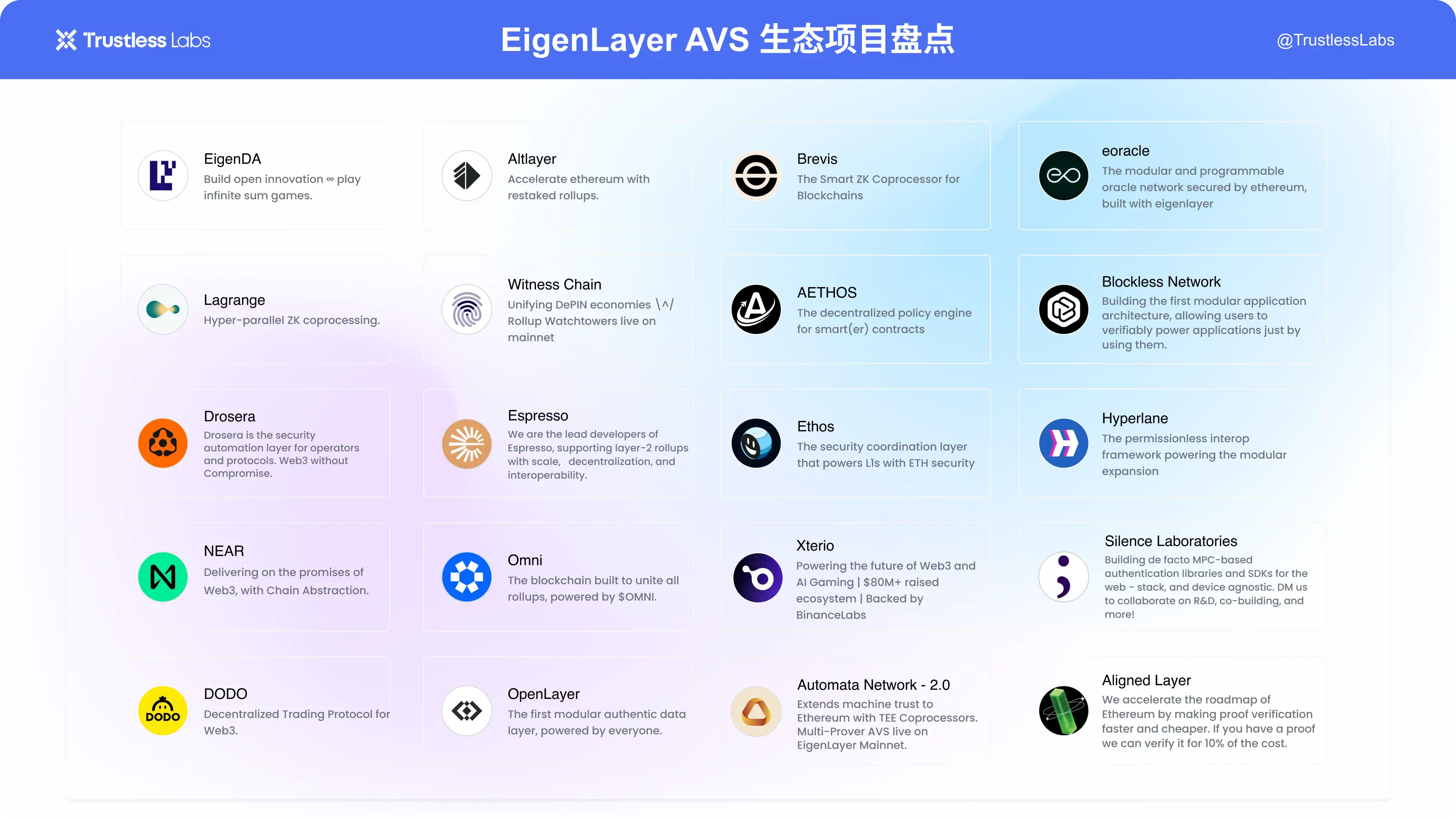
Overview of Eigenlayer Operation
Restaking refers to using ETH staked for Ethereum network validation to restake and share security with other protocols, while earning additional interest. Eigenlayer can receive native ETH participating in Ethereum PoS, as well as wrapped LST.
On EigenLayer, restakers can choose to delegate their restaking assets to Operators. Specifically, after restakers delegate their assets to Operators, the Operators will provide validation services for AVS (Actively Validated Services). Operators participate in the validation process of AVS by installing necessary software to ensure the correct and secure operation of AVS. In return, Operators receive validation rewards from AVS and return them to the restakers.
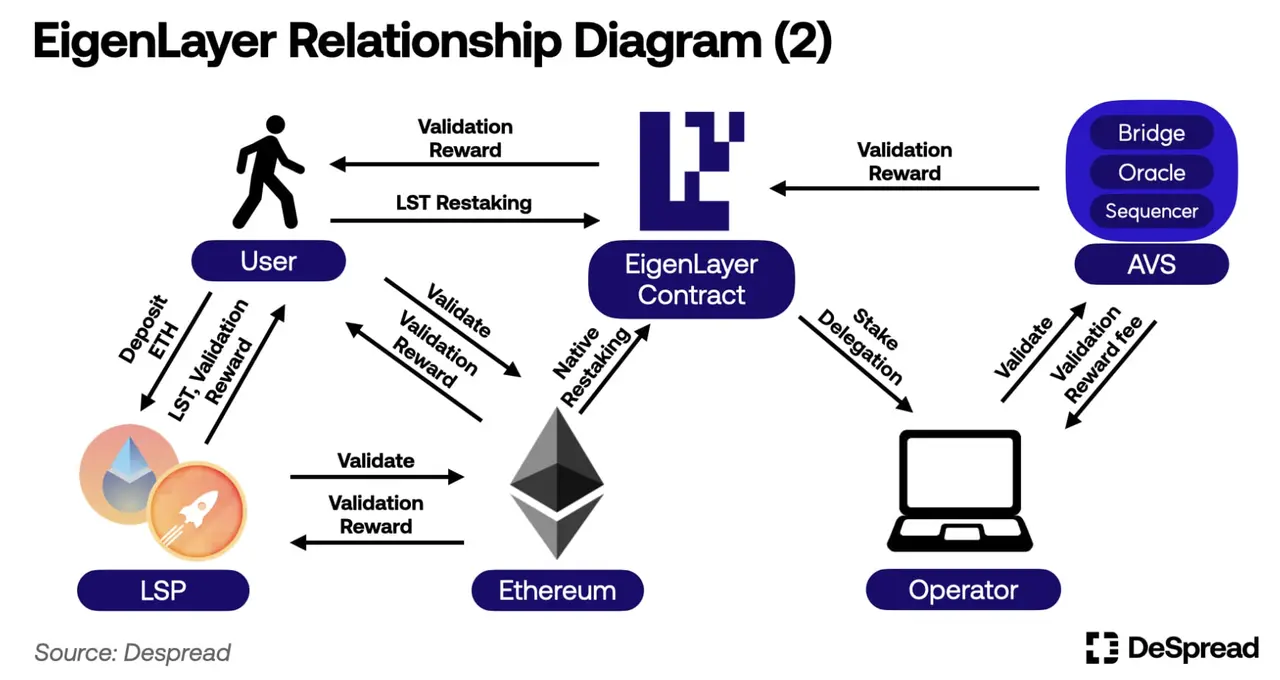
Image Source: DeSpread Research
- LRP (Liquid Restaking Protocol) is based on the principle of restaking, replacing user participation in Eigenlayer (for example, subsequent selection of Operators does not require user participation), while issuing a layer of LRT (Liquid Restaking Token) of the same value to the user.
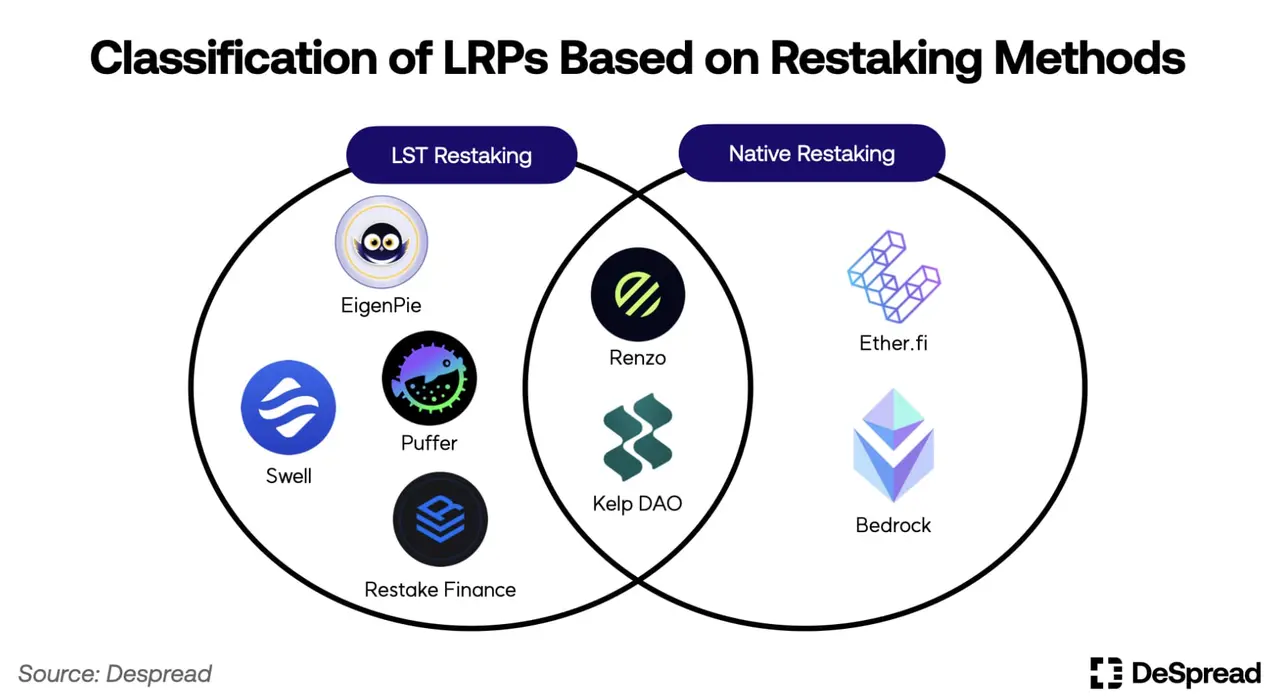
Image Source: DeSpread Research
In-depth Understanding of Operators & AVS
How to Become an Operator? What Service Does it Run? What Functions Does it Have?
An Operator can be an individual or an organization. By registering in EigenLayer, any Ethereum address can act as an Operator. An address can act as both a Restaker and an Operator at the same time (this dual role is not mandatory). Operators enable ETH stakers to delegate their staking assets (native ETH or LST) to them. Operators can participate in the EigenLayer network without the need to re-stake any tokens. Most Operators will receive token delegations from other restakers within the network. Otherwise, Operators can choose to self-delegate by allocating their restaked token balance.
Specifically, Operator nodes are based on Docker and Linux. After configuration and registration in eigenlayer-CLI (with a step requiring at least 1 ETH to be deposited), and meeting the standardization requirements of the corresponding node class, the software service of AVS can be run.
How to Become an AVS? What Service Does AVS Run?
AVS is any system that needs to verify its own distributed validation semantics, such as side chains, data availability layers, new virtual machines, guardian networks, oracle networks, bridges, threshold encryption schemes, trusted execution environments, etc.
Each AVS can design and implement its own contract as they see fit, as long as their entry point (referred to as 'ServiceManager' in the specification) implements the interface expected by the EigenLayer protocol.
How does an Operator run multiple AVS services? Does AVS have the right to choose?
Quorums are a set of strategies that AVS uses to share security measures.
Specifically, after the Operator completes the tasks given by AVS, they sign the results using BLS signatures and send the signed results to the aggregator entity. The aggregator uses BLS signature aggregation to combine these signatures into a single aggregate signature. Once Operators reach the quorum threshold, the aggregator sends the aggregate signature back to the AVS contract. Then, the AVS contract verifies whether the results meet the arbitration threshold and whether the aggregate signature is valid. Through this design, AVS aggregates the computations of multiple Operators to enhance security.
Conversely, Operators can choose to join one or more AVS validations (one fish, multiple eats), depending on their preferences and the design of AVS operations, as long as they have sufficient TVL.
Currently, the Eigenlayer official website can show which AVS different Operators have participated in. Most of them run multiple AVS services, while a few have only joined one AVS (such as ether.fi-8, which has only joined EigenDA). Some, like Puffer, have not yet joined any AVS validation.
AVS provides standardized descriptions of workload levels (e.g., lightweight, heavyweight), the design of the minimum work unit, and the conditions for slashing, and cannot selectively choose Operators.
Underlying Logic of the Business Model: Can Operators receive token incentives from AVS? Why do Operators help AVS with security validation?
When an Operator runs the software required for AVS and participates in validation tasks, they ensure the security and proper operation of AVS. These validation tasks may include executing consensus protocols, validating data availability, and more. Upon successful completion of the tasks, the AVS contract will pay the Operator the corresponding validation rewards, which include the user's restaking earnings.
Operators also face the risk of being penalized for misconduct or failure to fulfill their validation duties. The core contracts of EigenLayer include strict penalty mechanisms, and if an Operator exhibits malicious behavior or fails to validate as required while participating in AVS, their staked ETH may be penalized.
In terms of rewards for ordinary users, whether it's the Eigen official website or PoS browsers like StakeRewards, there is no clear APY that Operators can provide. Therefore, for ordinary users, there is no single authoritative indicator to choose an Operator. The available data includes restake concentration, AVS participation by Operators, restaked value, stakers, and other dimensions of reputation evaluation. Users need to make their own judgment in selecting an Operator. If users use other LRP protocols, they can ignore this step as the protocol will handle it on their behalf.
Participation Opportunities
Operators with Expected Token Issuance:
Puffer: 100 $Eigen can receive 1000 Puffer points, but Puffer has not yet joined any AVS validation.
InfStones: Raised $110M, currently the second-largest Operator on Eigenlayer (by the number of stakers), has joined 11 existing AVS on the official website. Can earn Infstones loyalty points. Highly recommended. Points can be earned through staking delegation, invitations, and early bird additional rewards. Additionally, there are milestone additional rewards distributed according to the loyalty points ranking.
Earning through Delegation: All delegators to InfStones on EigenLayer will accumulate loyalty points from day one. Each ETH delegated can accumulate 1,000 loyalty points per day. Example: Delegating 10 ETH for 90 days can accumulate 900,000 loyalty points.
Early Bird: Users delegating to InfStones on EigenLayer within the first 4 weeks will receive an additional 15% boost in overall loyalty points. Example: Delegating 10 ETH to InfStones on EigenLayer within the first 4 weeks and holding for 90 days. Early bird reward: 10 * 1,000 * 90 * 15% = 135,000 loyalty points.
Referral Bonus: Increase points by referring friends to InfStones, earning an additional 10% of loyalty points. Example: If there are 3 referrers, each will receive 10,000 loyalty points. Loyalty points from referrals: 10,000 * 3 * 10% = 3,000 loyalty points.
How to Obtain Tokens from AVS Projects
Looking at the already issued token Omni from AVS project, the number of tokens allocated to Eigenlayer Restakers is 400k, accounting for approximately 4% of the unlocked tokens in this TGE.
Omni tokens are not allocated based on Operators, but are airdropped based on Eigen points, and the top 15,000 ranked accounts can receive the Omni airdrop.
Cross-Investment Among Investors
- The overlap between investors in Eigenlayer and investors in completed financing AVS projects in the ecosystem is not significant overall, but there is some overlap. Looking at the projects, investors in AltLayer, such as Polychain Capital and Hack VC, are also investors in Eigenlayer. Investors in Espresso, such as a16z and Polychain Capital, are also investors in Eigenlayer. Additionally, several AVS projects (Omni, Lagrange, Hyperlane) have no intersection with investors in Eigenlayer.
Latest Developments
On April 10th, EigenLayer and EigenDA went live on the mainnet.
On April 30th, the Eigenlayer Github repository updated the $EIGEN whitepaper.
Token claims began on May 10th, and the newly established independent non-profit Eigen Foundation will be the entity issuing the tokens. The total supply of Eigen tokens at the time of issuance is 1.67 billion, with 45% of the tokens allocated to the community, further subdivided into equity input (15%), community initiatives (15%), and ecosystem development (15%). Additionally, 29.5% of the tokens will be allocated to investors, and early contributors will receive 25.5%. It is reported that the total lock-up period for investors and early contributors is three years, with the first year fully locked, followed by a gradual release of their holdings at a rate of 4% per month over the next two years.
The first season will have a total of 113 million EIGEN, with 6.05% initial supply allocation for the first phase and 0.7% token allocation for the second phase; the remaining 8.25% of tokens will be allocated for future airdrop seasons (the first season and the second phase are expected to start in mid-June).
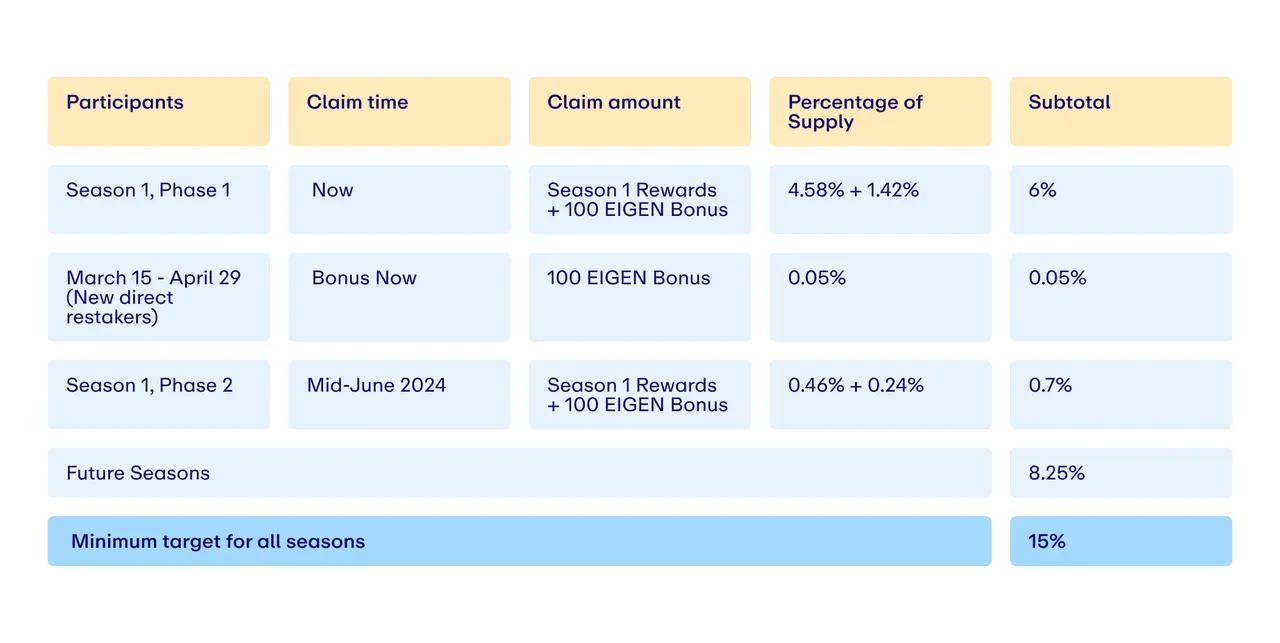
Inventory of AVS Ecosystem Projects
EigenDA
EigenDA is the first DA (Data Availability) service launched by Eigen, which has already gone live on the mainnet. EigenDA closely follows the scaling path of Ethereum Danksharding, so its DA layer technology path is highly related to the scaling technology path of Ethereum Danksharding. Furthermore, EigenDA adopts technologies such as erasure coding, KZG commitments, and ACeD (Authenticated Coded Dispersal), and decouples DA from consensus, demonstrating excellent performance in transaction throughput, node load, and DA costs. Rollup publishes data to EigenDA to achieve lower transaction costs, higher transaction throughput, and security composability within the EigenLayer ecosystem.
As of May 8th, the TVL (Total Value Locked) of EigenDA's mainnet has reached 3.2M ETH, with a market value of 9.7B, accounting for approximately 4% of the total market value of ETH. Projects such as AltLayer, Caldera, Celo, Layer N, Mantle, Movement, Polymer Labs, and Versatus have already partnered with EigenDA and plan to use EigenDA's DA service.
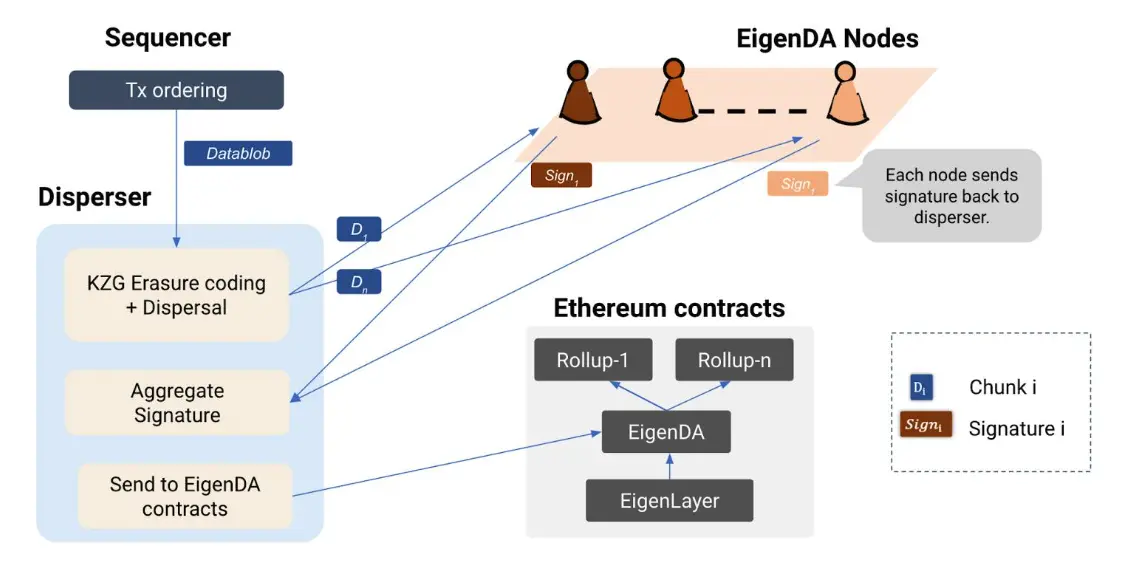
- The technical roadmap of EigenDA is based on three components: Operator, Disperser (untrusted), and Retriever (untrusted). Operators run EigenDA node software, responsible for storing blobs associated with valid storage requests. Dispersers, hosted by EigenLabs, are responsible for encoding blobs using Reed-Solomon coding, computing KZG commitments for the encoded blobs, and generating KZG proofs for each block. The dispersers then send the blocks, KZG commitments, and KZG proofs to the operators, who return the signatures. Dispersers aggregate these signatures and upload them to the Ethereum mainnet in the calldata form of the EigenDA contract to penalize improper behavior by operators. Retrievers are used to query blob blocks and verify their accuracy to reconstruct the original blob. The specific implementation process includes: Rollup Sequencer creates data blobs and requests dispersers to split them, dispersers encode the data blobs and generate KZG proofs, send the data blocks, KZG commitments, and KZG proofs to be verified and signed by EigenDA nodes, and finally aggregate the signatures uploaded to the EigenDA contract on the Ethereum mainnet.
AltLayer
- AltLayer is a provider of Rollups as a Service (RaaS), specializing in deploying and managing Rollups customized for different application requirements. AltLayer has launched and supports over 30 application-specific Rollups, covering blockchain stacks such as OP Stack, Arbitrum Orbit, Polygon CDK, ZKStack, many of which have integrated EigenDA's DA service.
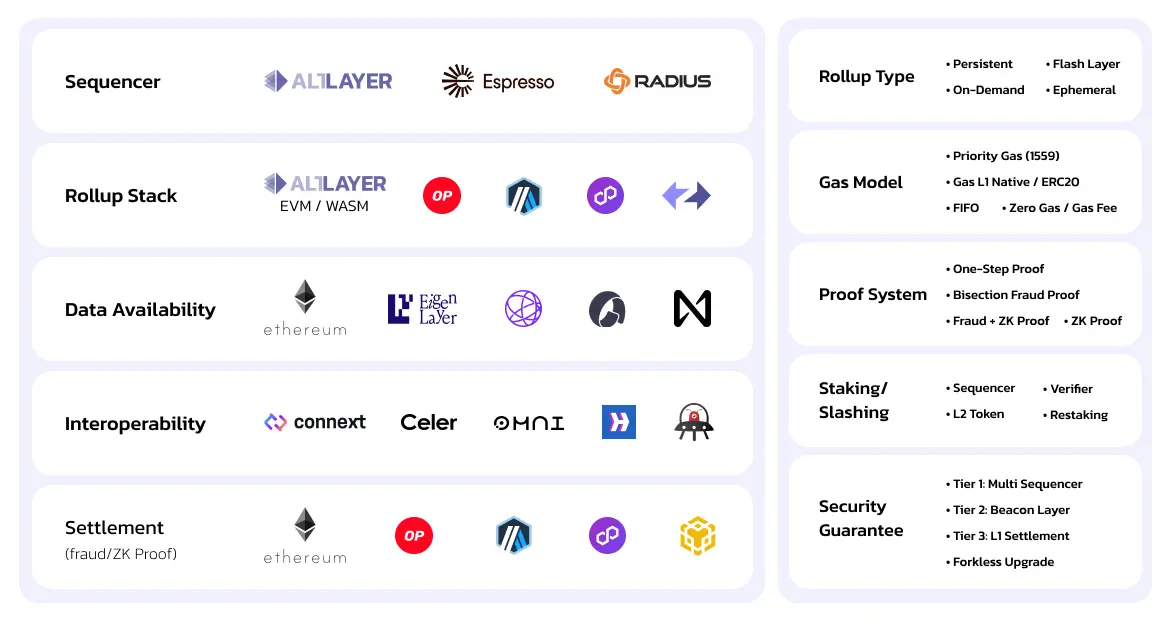
AltLayer adopts Restaked Rollup technology, combining restaking and Rollup technology to enhance the security, decentralization, and performance of the blockchain. AltLayer introduces three modular components: VITAL, MACH, and SQUAD, for decentralized state verification, fast finality, and decentralized sequencing, respectively. MACH is AltLayer's AVS (displayed as AltLayer MACH in Eigenlayer's AVS interface), providing fast confirmation of rollups transactions, encrypted economic security (detecting malicious network participants), and decentralized verification of rollups states.
AltLayer has raised $21.6M, with participation from Binance Labs, and a strategic financing round on February 19th led by Polychain Capital and Hack VC. Currently, AltLayer has a market value of 420M and a FDV (Fully Diluted Valuation) of 3.8B.
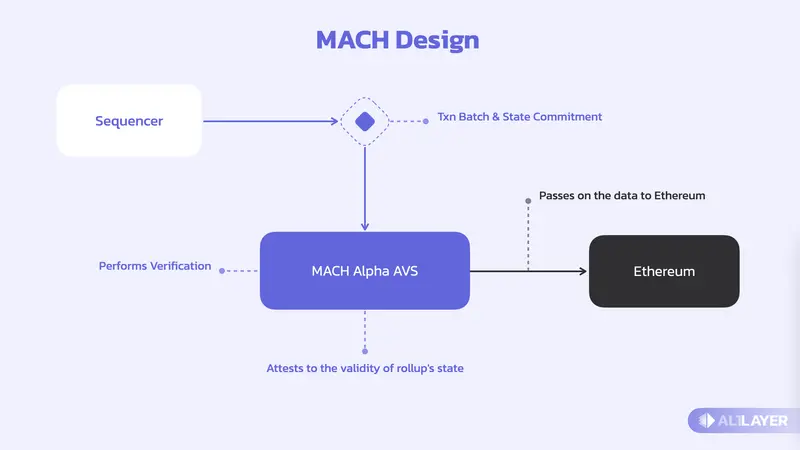
Brevis
Brevis is a ZK coprocessor implemented through AVS, featuring a modular architecture and proposing the coChain solution to reduce the cost of fully smart contract and zero-knowledge proof-based ZK coprocessors. Brevis coChain is a PoS chain that secures its security through ETH staking, combining OP and ZK mechanisms to initiate challenges through ZKP and punish malicious parties.
Brevis's architecture consists of three components: zkFabric, zkQueryNet, and zkAggregatorRollup. zkFabric collects block headers from all connected blockchains, generates consensus proofs after proving their validity through ZK light client circuits, and provides dApps with access to block headers and blockchain state. zkQueryNet is an open market for ZK query engines, accepting data queries from on-chain smart contracts, generating query results and ZK query proofs. zkAggregatorRollup acts as an aggregation and storage layer for zkFabric and zkQueryNet, verifying and storing proof data, and submitting zk proof state roots. Brevis has demonstrated its powerful ZK light client circuit performance in concept validation, supporting Ethereum PoS, Cosmos, and BNB Chain, enabling EVM and non-EVM chains to access the state of these three chains in a trustless manner.
The table below summarizes some key circuit performance benchmark data (obtained from a Linux server with 20 cores, 2.3GHz, and 384GB of memory, testing without GPU acceleration). Using these ZK light client circuits, a zkBridge for cross-chain assets between Ethereum Goerli and BNB Chain has been implemented.
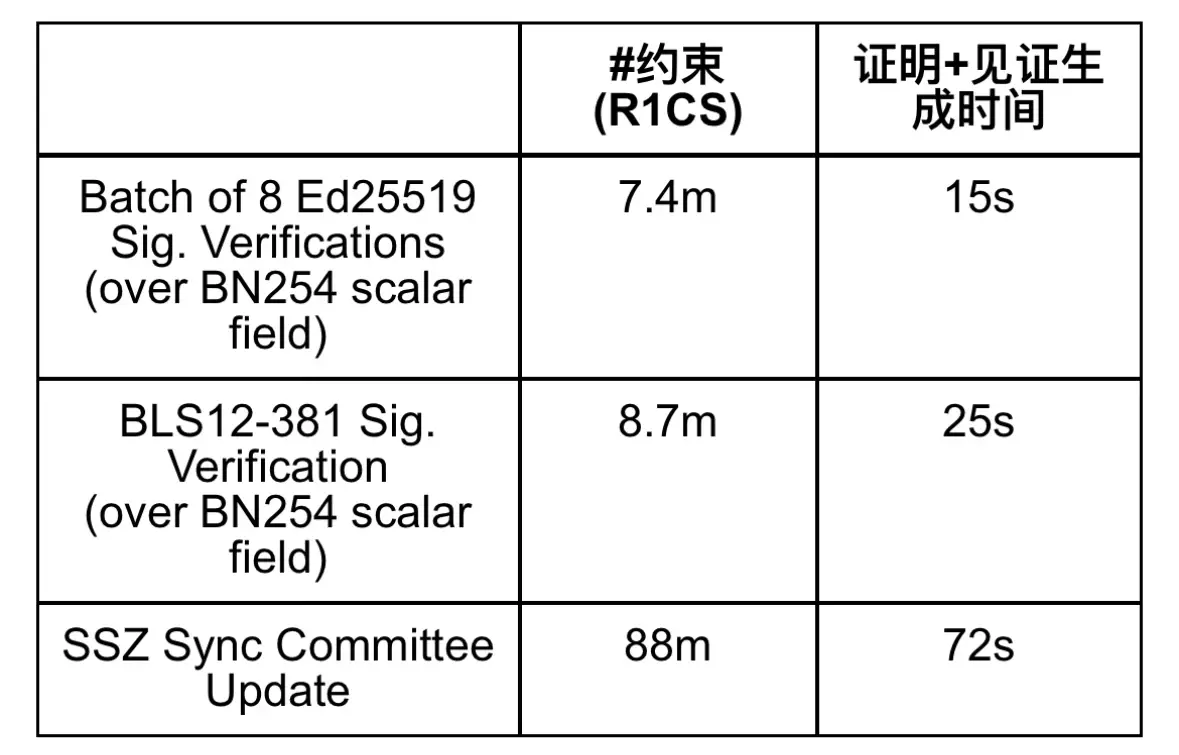
Eoracle
Eoracle is a modular and programmable oracle network, with its security guaranteed by ETH native rather than using external tokens like LINK. The technical stack of Eoracle uses eBF, consisting of the IBFT consensus engine and the Aegis protocol for external validator set configuration. eBFT utilizes the IBFT consensus engine to seal blocks, provide network capabilities, and govern the network. Eoracle's smart contracts on Ethereum work in conjunction with the Tendermint-based consensus engine, fully implementing the Aegis protocol. The Aegis-configured validator set of eBFT configures validators through a re-staking function and records commitments of eoracle state. Its features include: instant block finality, with only one block proposed per chain height to avoid forks and uncle blocks; reduced time between blocks to increase block production rate; high data integrity and fault tolerance to ensure each proposed block is validated by approximately 66% of validators, thereby ensuring the security and performance of the chain.
Lagrange
Lagrange is a parallel ZK coprocessor focused on cross-chain interoperability. The project completed a funding round in May 2023, raising a total of $4M, led by 1kx, with participation from CMT Digital, Maven 11 Capital, Lattice, and Daedalus. Lagrange's distinguishing feature is its "parallel" architecture, differentiating it from Brevis. In mid-2023, Lagrange had already launched testnets on Base, Arbitrum, and Optimism. Each node joining Lagrange's cross-chain state committee must stake over 32 ETH.
Witness Chain
Witness Chain is a DEPIN network designed for decentralized IoT devices. The network includes multiple components, such as DCL (DePIN Coordination Layer), providing essential services for the DePIN ecosystem, such as the security of the chain itself, node bandwidth, and physical location. These essential services, known as Watchtowers, are used to measure the above data, generate valid proofs in the DCL layer, and make them available for use. Witness Chain's watchtower mechanism achieves super-scalability by verifying transactions on another chain and publicly releasing transaction data for anyone to view. If erroneous transactions are detected, Ethereum validators can use fraud proofs for arbitration. The Rollup Watchtower Network acts as the internal DePIN of Witness Chain, serving as the first line of defense for L2 Op-Rollups such as Optimism and Base, allowing operators to actively verify aggregated transactions and ensure detection of any fraudulent behavior.
AETHOS
AETHOS is a decentralized policy engine that can execute customizable rules and conditions for on-chain transactions. Leveraging off-chain computation and encrypted economic consensus implemented through EigenLayer, it provides a flexible and secure policy layer for blockchain applications. AETHOS's network power includes pre-transaction policies set at the smart contract level, only executing transactions when complying with the rules set in the corresponding smart contract. It can access on-chain and off-chain data (such as historical fund flows, blockchain analytics, verifiable credentials, dynamic permission lists, etc.) to enforce policies. AETHOS provides a trust-minimized rule-making system for application developers to implement policies executed by economically incentivized operator networks, with policies publishable and modifiable by specific individuals, groups, or communities.
Blockless Network
Blockless Network is a modular network architecture with dynamic resource matching and random distribution capabilities. Blockless uses a random allocation algorithm for task assignment to reduce the risk of malicious behavior on the network. It also features a WASM secure runtime, enabling support for applications built in various mainstream programming languages (including Python, JavaScript, Go, and Rust), expanding accessibility and allowing developers to easily integrate their applications. Blockless's dynamic verification mechanism further enhances its security and performance.
Drosera
Drosera is a secure protocol that uses hidden security intent to contain and mitigate attacks in a decentralized event response protocol. The protocol detects and responds to potential network threats and attack behavior through covert security operations, thereby enhancing the overall security of the blockchain network.
Espresso
Espresso provides a decentralized sequencer solution for connecting L2 solutions (shared sequencing market and finality tools). Espresso is building a shared sequencing market, allowing rollups to auction off their sequencing rights for block construction. Its core technology includes Espresso's sequencing market and HotShot shared finality layer. Compared to Metis, Espresso provides modular Sequencer shared components to handle transaction sequencing requirements for all Rollups.
On March 22, 2024, Espresso Systems completed a $28M Series B financing round, led by a16z. The latest round of financing brings Espresso's total funding to over $60M.
User transaction requests first go through Espresso's shared Sequencer hub, then batch processed status back to layer2. Using the Hotshot proof-of-stake system to ensure the decentralization and incentive mechanism of the Sequencer. Leveraging the Ethereum secure consensus provided by Eigenlayer.
Espresso's sequencing market allows L2 Rollups to sell their sequencing rights in a combination lottery run, with plans to launch a simplified version of the market in Q2 2024. The HotShot shared finality layer is Espresso's consensus protocol and shared finality layer, finalizing the results of the combination lottery and L2 transactions. Nodes participating in the HotShot consensus also form Tiramisu (Espresso's data availability layer). L2 applications (including Rollups) interact with Espresso and with L1 chains to facilitate trustless state checkpoints. Espresso runs smart contracts on Ethereum, tracking HotShot state commitments and allowing other projects to reuse these state commitments on other chains.
Ethos
- Ethos is a security layer that enables the Cosmos chain to utilize the economic security of re-staked ETH to guide the validator network. ETH stakers can re-stake their ETH on EigenLayer by delegating tokens to operators supporting Ethos. These operators allocate delegated stakes to a selected group of guardians, who validate the Ethos Layer 1 chain (referred to as the "Guardian Chain"). By opting into a mechanism of shared security, these guardians can collectively validate or delegate to protect any combination of L1 chains, extending the security of re-staked ETH beyond the Ethereum ecosystem. The Ethos ecosystem consists of three layers: AVS contracts deployed on EigenLayer can securely delegate re-staked ETH to Ethos Guardians; using re-staked ETH to collectively validate or delegate to other L1 Guardian chains; and Ethos-driven chains, facilitating decentralized trust networks and/or enhancing their economic security through guardians.
- Hyperlane
Hyperlane is a universal and permissionless interoperability layer (application building platform) built for modular blockchain stacks. In September 2022, Hyperlane completed a $18.5M financing round, led by Crypto Investor Variant, with participation from Galaxy Digital, CoinFund, Circle, Figment, Blockdaemon, Kraken Ventures, and NFX. In September 2023, Hyperlane launched the V3 mainnet.
- Near
NEAR is a chain-abstracted stack, utilizing sharding and PoS for L1 blockchain. NEAR's current main narratives include Chain Abstraction (CA), Data Availability (DA), and Artificial Intelligence (AI). These narratives showcase NEAR's technical diversity and innovation, positioning it prominently in the blockchain ecosystem and providing rich functionalities and use cases for developers and users.
- Omni
Omni is an integrated Rollup layer for Ethereum, addressing the interoperability of Rollups on L1. Omni's narrative is to address the fragmentation caused by Rollups (which Omni considers the biggest existential threat to Ethereum). As Rollups become more prevalent, Ethereum users and their capital are increasingly dispersed into isolated ecosystems, reducing global network effects. Omni addresses this issue by integrating all Rollups into a cohesive, interoperable network. Omni's features include a dual staking model (ETH + OMNI), fast verification using Tendermint and CometBFT, support for diverse Rollups, and backward compatibility.
The TGE was completed on April 17, 2024, with a current market value of $149M and FDV of $1.42B.
- Silence Laboratories
Silence Laboratories provides a versatile toolkit for MPC-TSS and privacy-preserving computation, characterized by speed, generality, and scalability. Although the project has limited information on Twitter and documentation, its MPC library demonstrates strong potential and practicality in the field of multi-party computation and privacy-preserving computation.
- Xterio
Xterio is an Alt-derived chain focused on the gaming ecosystem of L2 blockchain. Xterio has issued a second-layer blockchain based on EigenDA and OP Stack using AltLayer's RaaS, focusing on scenarios related to AI and Web3 games. Xterio L2 utilizes AltLayer MACH (AVS for fast finality), which AltLayer also provides to Optimism's mainnet. Through these technologies, Xterio provides an efficient and powerful blockchain platform for game developers and users.
- Aligned Layer
Aligned Layer, based on ETH, aims to provide cost-effective zero-knowledge proof verification.
On April 25, 2024, it announced the completion of a $20M Series A financing round, led by Hack VC, with participation from dao5, L2IV, Nomad Capital, and others. Just ten days before the Series A financing, on April 15, 2024, it completed a $2.6M seed round, led by Lemniscap, with participation from Bankless Ventures, Paper Ventures, Sreeram Kannan, Brandon Kase, Daniel Lubarov, DCbuilder, Chainyoda, Weikeng Chen, Sami BENYAKOUB (samnode_), Peter Fittin (SizeChad), Lucas Kozinski, as well as strategic investments from StarkWare and O(1)Labs.
AlignedLayer aims to be a universal verification layer no longer constrained by the speed and cost of the EVM. AlignedLayer receives proofs of different sizes and verification times from various sources, has dedicated validators to quickly check the validity of each proof, and publishes the results to Ethereum. Users can choose to obtain fast soft finality on AlignedLayer or wait for hard finality on Ethereum. The current progress expectation is to launch the Eigenlayer public testnet in May and the mainnet in September.
- Automata Network2.0
Automata is a modular proof layer that introduces TEE (Trusted Execution Environment) coprocessors (a new concept in EigenLayer AVS), with a narrative to help Rollups become open, modular, and verifiable. In its introduced Proof of Machinehood, it utilizes Op Rollup and zero-knowledge proofs to achieve hardware authentication on-chain, ensuring the authenticity and uniqueness of machines. It is positioned as a Multi-Prover AVS, allowing decentralized networks to securely execute and verify computations using TEEs from multiple heterogeneous suppliers. AltLayer supports the one-click deployment of Automata Network's modular framework.
- As early as February 2022, Automata Network received strategic investment from Binance Labs. In August 2023, Automata Network announced the official launch of the Automata 2.0 testnet (in collaboration with AltLayer), extending machine-level trust to Ethereum.
Openlayer
Openlayer's narrative is a modular data layer. In implementation, it uses OVC (Optimistic Verifiable Computation) and modular verification components. The project is building an AVS called OpenOracle, allowing user-operated nodes to provide and verify external data sources for smart contracts in an optimistic and verifiable manner.
- Endorsed by a16z CSX, Geometry Ventures, LongHash Ventures, and others.
Dodo
DODOchain is positioned as the Omni Trade Layer3, supported by Arbitrum Orbit, EigenLayer, and AltLayer (built on AltLayer MACH). DODOchain will utilize EigenDA to provide Ethereum's consensus and security features. It connects Ethereum aggregation and the Bitcoin network, integrating liquidity into one platform to achieve seamless cross-chain transactions.
- It has been launched, with $DODO market cap of 103M and FDV of 168M.
免责声明:本文章仅代表作者个人观点,不代表本平台的立场和观点。本文章仅供信息分享,不构成对任何人的任何投资建议。用户与作者之间的任何争议,与本平台无关。如网页中刊载的文章或图片涉及侵权,请提供相关的权利证明和身份证明发送邮件到support@aicoin.com,本平台相关工作人员将会进行核查。




